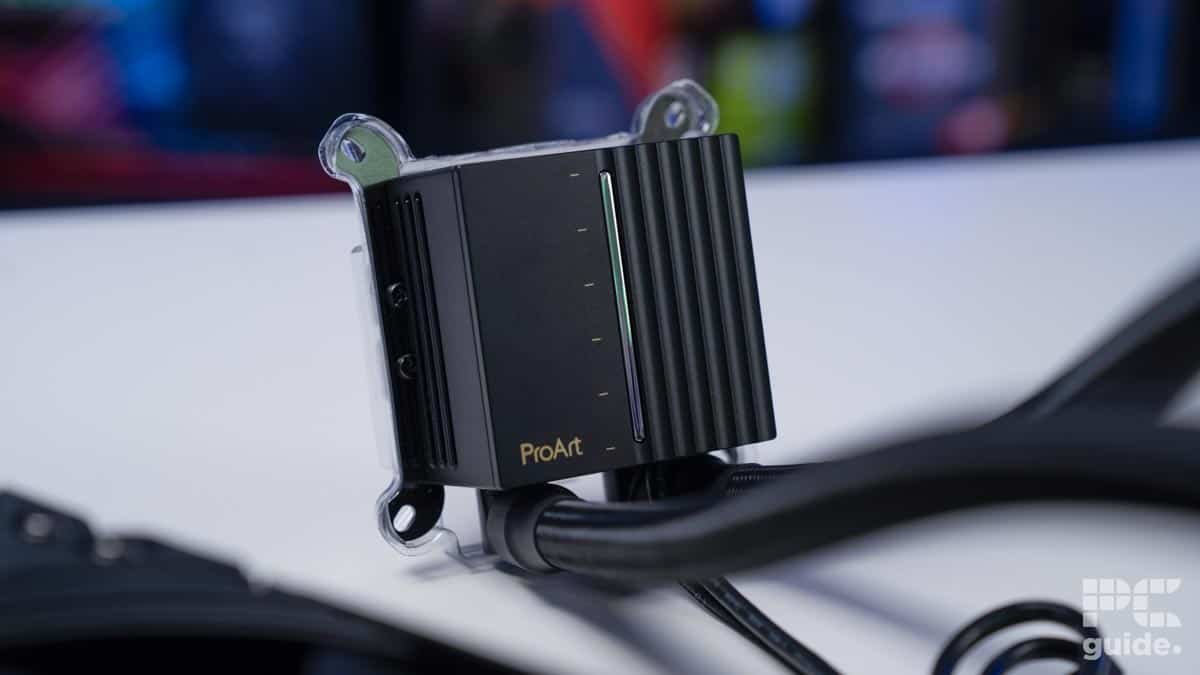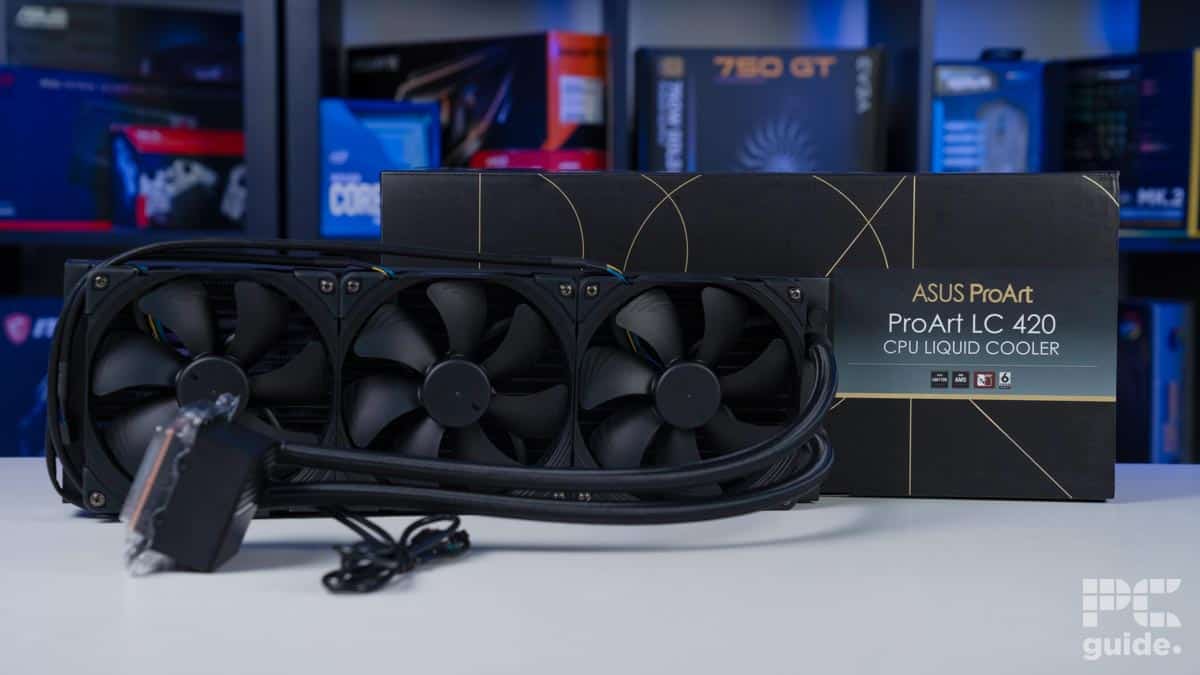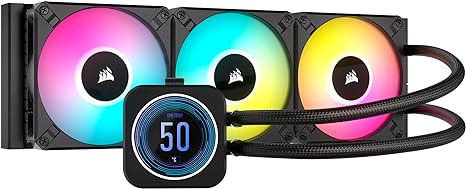ASUS ProArt LC 420 review – Is it worth it?

Table of Contents
This ASUS Pro Art cooler is among the biggest AIO coolers available on the market, with a radiator size of 420mm and comes equipped with three 140mm fans, it’s easy to expect some serious cooling performance from this beast. When you think of CPU coolers, you don’t really think of ASUS and its ProArt lineup, however, ASUS saw this as an opportunity and created an AIO liquid cooler designed for the creatives out there.
This cooler is the only one on the ProArt roster as of the time of writing and was first made available in December 2023. Since then, it has taken the world of CPU coolers by storm, earning very good reviews across the board, but how will it fare in our CPU benchmarks?
Prime Day may have closed its doors, but that hasn't stopped great deals from landing on the web's biggest online retailer. Here are all the best last chance savings from this year's Prime event.
- Sapphire Pulse AMD Radeon™ RX 9070 XT Was $779 Now $719
- AMD Ryzen 7 7800X3D Processor Was $449 Now $341
- Skytech King 95 Ryzen 7 9800X3D gaming PC Was $2,899 Now $2,599
- LG 77-Inch Class OLED C5 TV Was $3,696 Now $2,996
- AOC Laptop Computer 16GB RAM 512GB SSD Was $360.99 Now $306.84
- Lexar 2TB NM1090 w/HeatSink SSD Was $281.97 Now $214.98
- Apple Watch Series 10 GPS+ Smartwatch Was $499.99 Now $379.99
- AMD Ryzen 9 5950X processor Was $3199.99 Now $279.99
- Garmin vívoactive 5 Smartwatch Was $299.99 Now $190
*Prices and savings subject to change. Click through to get the current prices.

- Cooling Method: Liquid
- Noise level: 31.5dBa
- Material: Copper, Aluminium
- Fan size: 140mm
- Max fan speed : 2,000 rpm
- Thermal paste: Pre-applied
The ProArt is a fantastic cooler designed to be utilized by creatives, or people who regularly put a lot of strain onto their CPU. This cooler is designed to be the best, and integrate seamlessly into any PC case that can accommodate is huge 420mm radiator. However, all that cooling power does come at a cost, but we think it’s good value for money.
- Fantastic cooling performance
- Sleek, minimal design
- Noctua fans
- Pricy compared to other coolers
- No screen, you’d expect one for this price, however, can be a plus if you don’t want a screen.
Why we gave this cooler a 4.5
This is one of the best coolers that we have ever tested, and it can be bought for a very reasonable price during sales events. The 420mm monster of a radiator can keep even the hottest and most powerful of CPUs cool. This cooler was designed for creatives, and for people who regularly put their CPU under a lot of strain. If this is you, or you are someone who just wants to get a CPU cooler now that give you the thermal headroom to upgrade CPUs for probably years to come, this CPU cooler might be for you.
To cut a long review short, we like this cooler. It is a little on the expensive side, and it’s only available in the 420mm variant, but it is purpose-built to keep the temperatures of even the hottest CPUs under control and to do that, you need some serious surface area. If you don’t need this much cooling performance, you might be better off grabbing a smaller AIO to save some money, ASUS has plenty of options there. All in all, this cooler performs very well when paired with our 14600k, and the ProArt never really saw it as much of a challenge. Temps remained cool across the boars, even under the heaviest of loads.
What’s in the box
Because we had a review sample of the ASUS ProArt LC 420, we unfortunately didn’t receive all the necessary parts to utilize it properly, as a result, we needed to use other mounting hardware to get the CPU cooler working properly. Luckily, we had the spare parts to facilitate this fix, however, as a result of this, we can’t show you the complete contents of the box. We can, however, tell you what you will get if you decide to order one for yourself.

- 1 x CPU Liquid Cooler (pre-applied thermal compound)
- 1 x 1-to-3 Fan Splitter Cable
- 1 x Accessory Pack of Screws and Brackets
- 1 x Quick Start Guide
ASUS is very descriptive as usual, the cooler comes with compatibility for sockets LGA 1700, 1200, and 115x from Intel and AM5 plus AM4 for AMD. It’s also worth noting that this cooler comes with a 6-year warranty, which does not cover accidental damage during installation.
Design
The design of this cooler is very much sleek and stylish, it carries less of the industrial aesthetic than the Ryujin and less of the rotundness of the Ryuo. However, it still carries a semi-industrial flair. The primary materials are similar to the other ASUS coolers on offer, copper, aluminum, and nickel. The build quality of the radiator feels extremely premium and robust, it is easy to bend the fins on the radiator, however, but that is the same for all radiators.

The fans are Noctua NF-A14 Industrial PPC-2000 140mm fans, that was a mouthful. These fans are capable of pushing 107CFM at a speed of 2000RPM, while only achieving a peak noise level of 31.5dB(A). It’s partly due to these fans that the ProArt is able to perform so well when cooling our 14600K.
The tubes are made of sleeved rubber, offering flexibility as well as robustness. We’re fully confident that these tubes will never crack or falter under normal circumstances. The same can be said for the CPU block, the joining connections to the CPU block feel about as indestructible as you would want them to be. The cold plate is flat, well-designed, and seems to mount securely to the motherboard.
Installation
Installation is pretty typical of an AIO cooler, you attach the fans to the radiator and install that same radiator into your PC case. The fans are attached via fan screws, which is a pretty standard configuration. Be ready to test your wrist strength, however, as this beefy 420mm radiator can get a little heavy when holding it for long periods.
Performance
The performance of this cooler is unlike anything we have tested here on PCGuide, but before we get into that, we need to outline the components we use on our test bench. We do this for transparency, as components are a factor when recording ambient temperatures, especially during stress testing. We keep these components the same across all tests, this helps ensure each component we benchmark is on an even playing field.
Here are the components we used in our CPU cooler test bench:
| Component | Name |
| CPU | Core i5-14600K |
| Memory | Corsair Vengence @ 6400MHz |
| Motherboard | Crosshair Dark Hero Z790 |
| GPU | RTX 4070 Ti Super |
| Power supply | ASUS ROG Thor 1000W |
| Case | Cooler Master Masterframe |
With that being said, let’s see how the ProArt did in our cooler benchmarks. To see how these benchmarks are performed, you can check out the PCGuide Labs page, which explains everything you need to know.
Idle CPU temperatures
| Idle cooling performance |
|---|
| CPU temp 27°C (core temp average) |
| CPU temp 33°C (max temp) |
| Air temp behind fans 27.8°C |
| throttle 0% |
Idle is the state in which your system doesn’t do much, it’s just on. No intensive applications running, just the programs necessary for a fully functional operating system. If the cooler can’t sustain temperatures at this level of usage, then there’s no chance it’ll be able to put up with any kind of stress testing, so we must analyze temperatures in this early stage. The ProArt doesn’t allow the CPU to get hotter than 32 degrees, so it’s safe to say it’s passed this part of the benchmark.
Aida Stress test cooling performance
| Aida Stress test cooling performance |
|---|
| CPU temp 57°C (core temp average) |
| CPU temp 72°C (max temp) |
| Air temp behind fans 30.8°C |
| throttle 0% |
Aida is about the worst thing you can do to your CPU, not really, but it is one of the heaviest loads you can ever impart on your processor. You will likely never load your CPU as heavily as this test does, so it’s perfect for testing how well CPU coolers cope with extreme loads. Considering that the ProArt didn’t let temps rise above 72, and they stayed at an average of 57, it passed with flying colors, it still has 23 degrees to the Tjmax, the max temperature before throttling occurs.
Blender cooling performance
| Blender cooling performance |
|---|
| CPU temp 57°C (core temp average) |
| CPU temp 70°C (max temp) |
| Air temp behind fans 31.0°C |
| throttle 0% |
Blender is a pretty intensive 3D modeling software, and the benchmark that we run on it is no easy feat either. The ASUS cooler has handled this task very well, only allowing a maximum temperature of 70 degrees and an average of 57. 3D modeling and rendering are usually left up to the GPU, but it can be done with the CPU, just less efficiently. But still, it’s nice to know that the CPU cooler can handle the load, should you need to use the CPU for this kind of workload, for whatever reason.
Handbrake ToS benchmark
| Handbrake ToS cooling performance |
|---|
| CPU temp 60°C (core temp average) |
| CPU temp 70°C (max temp) |
| Air temp behind fans 30.5°C |
| throttle 0% |
Handbrake is another benchmark we use to test the video encoding capabilities of the CPU. Not only is this an intensive application, but it also generates a lot of heat. We use the ToS test, which involves encoding a video from 4k to 1080P using a handbrake. When performing the benchmark, the ProArt didn’t let the temperatures rise above 70 degrees, and it maintained an average temperature of 60 degrees.
All in all, this cooler is fantastic for keeping high temperatures at bay, and we’d expect that to be the case considering it’s a 420mm cooler. Because of this, you’re going to want to check whether your current PC case can accommodate a radiator of this size before you pull the trigger on purchasing one. But if you want a cooler that looks the part, and plays it too, then this cooler is a fantastic choice.
What these benchmarks mean
We cast a wide net when we benchmark our CPUs and coolers because we want to encompass as many use cases as possible to represent performance accurately. We test with a lot of synthetic benchmarks, everything from video encoding to file compression and decompression. And what we’re looking for is low CPU temperatures.

The lower the CPU temperatures, both maximum and average, the better. Except when we’re looking at the temperature of the air out the back of the fan, a higher temperature indicates a larger amount of heat leaving the CPU. If the CPU temperatures are manageable across the board, we’d deem this cooler ideal for all circumstances. Of course, the better the CPU temps, the better the cooler is at cooling, which some would argue is the most important factor.
Alternatives to the Asus ProArt AC 420
The ASUS cooler we’re testing today is certainly a high-profile one with a lot of cooling potential, but what if it doesn’t tickle your fancy? There are a number of coolers that you can choose in its stead.
-
ASUS ROG Ryujin III 240
- Cooling Method: Liquid
- Noise level: 36.54dBa
- Material: Copper, Aluminium
- Fan size: 120mm
- Max fan speed : 2,000 rpm
- Thermal paste: Included
-
Corsair H150i ELITE LCD XT
- Radiator Type: Aluminium
- Fan Edition: 3x Corsair ML120 ELITE RGB PWM
- Max RPM: 2000 RPM
- Socket Support: Intel 1700, 1200, 1150, 1151, 1155, 1156, 1366, 2011, 2066 AMD AM4, AM3, AM2, sTRX4, sTR4
-
If you’re choosing this cooler because you’re interested in an AIO, or you have too powerful of a CPU to go with an Air cooler, these two options would be a fantastic pick. If you’re okay with LCD screens, then the ASUS ROG Ryujin III would be a fantastic choice, although the variant that we reviewed is only 240mm, it does come in a 360mm variant for some extra performance.
If you want something a little bigger that slots into the Corsair ecosystem, we have the Corsair H150i ELITE LCD XT, this 360mm AIO has a smaller, lower-profile screen than the Ryujin III does, in case that is not your thing, and iCUE integration means you can closely monitor anything going on with your CPU, cooler, or temperatures. A fantastic pick if there ever was one.
Price

As of the time of writing this review, the ProArt can be found for around $259, which is a big price to pay if it isn’t what you’re looking for cooling-wise. According to Camelcamelcamel, an Amazon price tracker, the cheapest it has ever been is $239, starting June 2024.
Conclusion
This is a very strong cooler, capable of cooling even the mightiest of CPUs struggling through the most intensive of tasks. There’s plenty of thermal headroom here for you to don CPUs even generations into the future. The ProArt was designed with creatives in mind, and creativity can create a very high demand on the CPU. Probably why this cooler only comes in the 420mm variant, if you’re going to do it, might as well do it right the first time.

- Cooling Method: Liquid
- Noise level: 31.5dBa
- Material: Copper, Aluminium
- Fan size: 140mm
- Max fan speed : 2,000 rpm
- Thermal paste: Pre-applied
The ProArt adequately cooled the 14600k through all benchmarks we performed and then some, in fact, it’s the best-performing cooler we’ve tested as of the time of writing, but it is the only 420mm – so that might be something to do with that. The more surface area you have for cooling, the better the cooling performance (usually). We highly recommend this cooler to anyone with a high-powered CPU running high-intensity creative workloads regularly.











